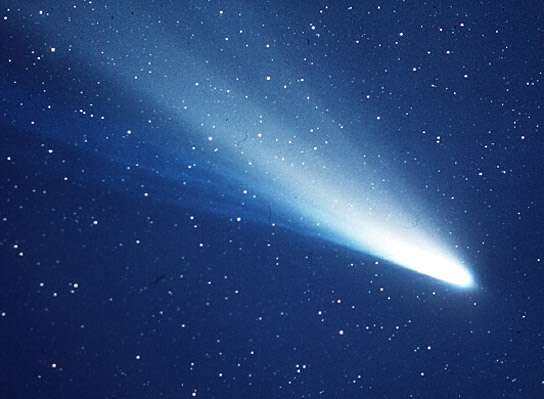December 10, 2015 report
Could molecular oxygen be common on comets?

(Phys.org)—A team of researchers, encouraged by the latest discovery of ESA's Rosetta spacecraft of molecular oxygen (O2) on the comet 67P/Churyumov-Gerasimenko, are going over comet 1P/Halley (known as Halley's Comet) with a fine-tooth comb, searching for the traces of this essential molecule. The new study, led by Martin Rubin of the University of Bern, Switzerland, shows that molecular oxygen is also present on 1P/Halley and therefore might be common on other comets.
The scientists used the data from the Neutral Mass Spectrometer (NMS) instrument aboard ESA's Giotto probe, which passed 1P/Halley in 1986. They found that O2 is the third most abundant species on this celestial body. The results were published on Dec. 4 in the Astrophysical Journal Letters.
Giotto approached Halley's nucleus at a distance of 596 kilometers. Despite being hit by the comet's small particles, the spacecraft gathered important scientific data during a flyby lasting only few minutes. This close encounter enabled the chemical characterization of the material being ejected from the comet. The results indicated that Halley releases mainly water and carbon monoxide. The data showed also traces of methane, ammonia, other hydrocarbons, as well as iron and sodium. Now, Rubin and his colleagues report abundant amounts of molecular oxygen in the comet's coma.
"Our investigation indicates that a production rate of O2 with respect to water is, indeed, compatible with the obtained Halley data, and therefore that O2 might be a rather common and abundant parent species," the scientist wrote in the paper.
The first comet on which molecular oxygen was detected is 67P/Churyumov-Gerasimenko, representing Jupiter family comets originating from the Kuiper belt. The Rosetta Orbiter Spectrometer for Ion and Neutral Analysis (ROSINA) found this molecule in October 2015, and since then, the scientists have wondered whether the O2 abundance is peculiar to comet 67P/Churyumov-Gerasimenko or Jupiter family comets in general. The new results hint that the existence of molecular oxygen could also be characteristic for the Oort cloud family of comets that includes Halley.
"We now have an indication for abundant O2 in the comas of two comets, one from the Oort cloud and the other from the Kuiper belt or possibly the scattered disk. This is particularly interesting, as both families of comets are believed to have formed at different locations in our early solar system," the paper reads.
The authors of the new study also address what caused the abundance of molecular oxygen on Halley. One possible explanation offered by the scientists is that the O2 has already been formed through irradiation of ices in the molecular cloud phase and the oxygen remained trapped before the comet eventually formed. According to the scientists, the close abundance of oxygen on both comets, despite very different dynamical histories and erosion rates, confirms this hypothesis.
Comets are essential to improving our understanding of the origins of life. These icy leftovers from the planet-forming process have been preserved at low temperatures since their formation. Thus, the cometary material could provide invaluable hints on how solar system was created.
Now, when we know that the presence of molecular oxygen is not unique to one comet, a new chapter opens in the search for the ingredients of life on the icy visitors from the outskirts of the solar system. With that in mind, further studies could reveal a vast number of comets rich in oxygen, water and even organic compounds.
More information: iopscience.iop.org/article/10. … pscience.cld.iop.org M. Rubin et al. MOLECULAR OXYGEN IN OORT CLOUD COMET 1P/HALLEY, The Astrophysical Journal (2015). DOI: 10.1088/2041-8205/815/1/L11
Abstract
Recently, the ROSINA mass spectrometer suite on board the European Space Agency's Rosetta spacecraft discovered an abundant amount of molecular oxygen, O2, in the coma of Jupiter family comet 67P/Churyumov–Gerasimenko of O2/H2O = 3.80 ± 0.85%. It could be shown that O2 is indeed a parent species and that the derived abundances point to a primordial origin. Crucial questions are whether the O2 abundance is peculiar to comet 67P/Churyumov–Gerasimenko or Jupiter family comets in general, and also whether Oort cloud comets such as comet 1P/Halley contain similar amounts of molecular oxygen. We investigated mass spectra obtained by the Neutral Mass Spectrometer instrument during the flyby by the European Space Agency's Giotto probe of comet 1P/Halley. Our investigation indicates that a production rate of O2 of 3.7 ± 1.7% with respect to water is indeed compatible with the obtained Halley data and therefore that O2 might be a rather common and abundant parent species.
Journal information: Astrophysical Journal Letters , Astrophysical Journal
© 2015 Phys.org





















